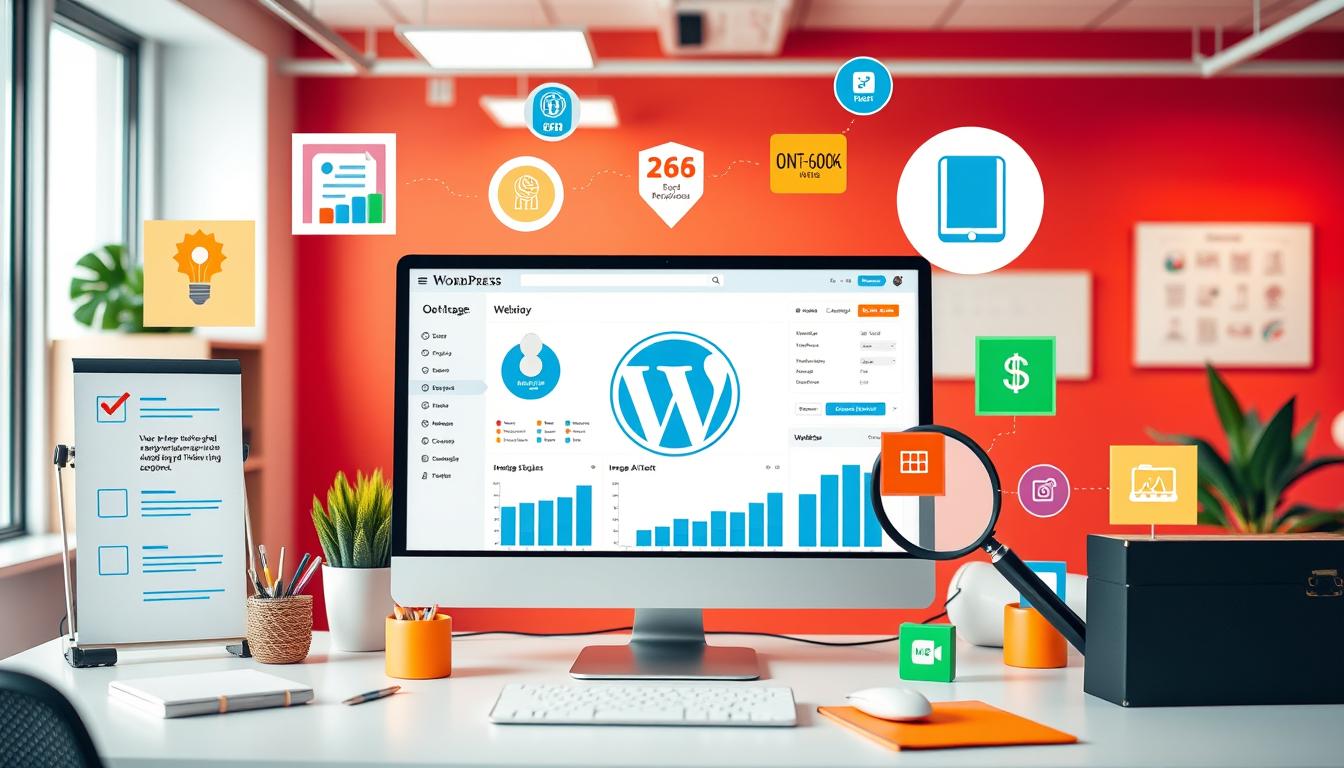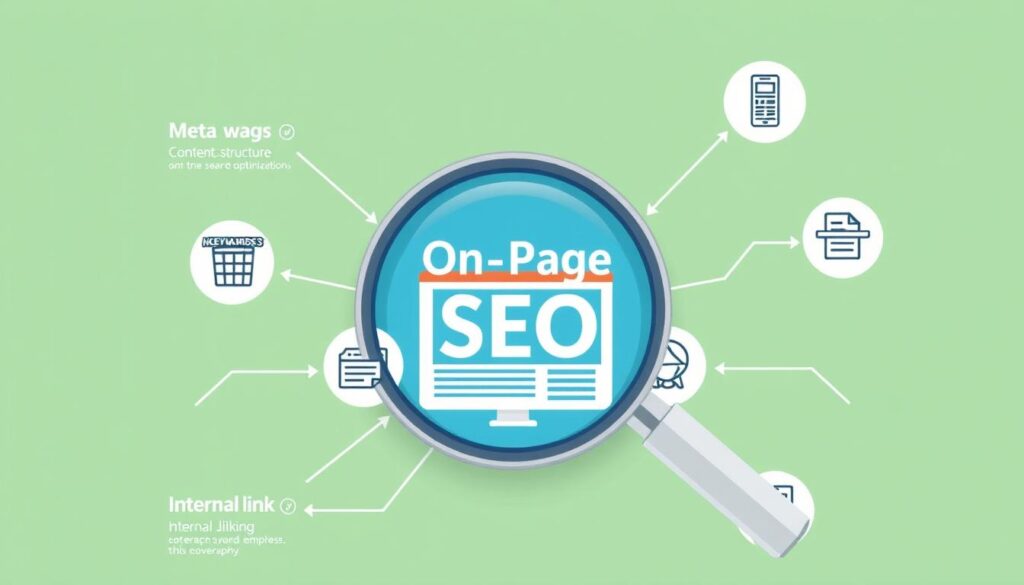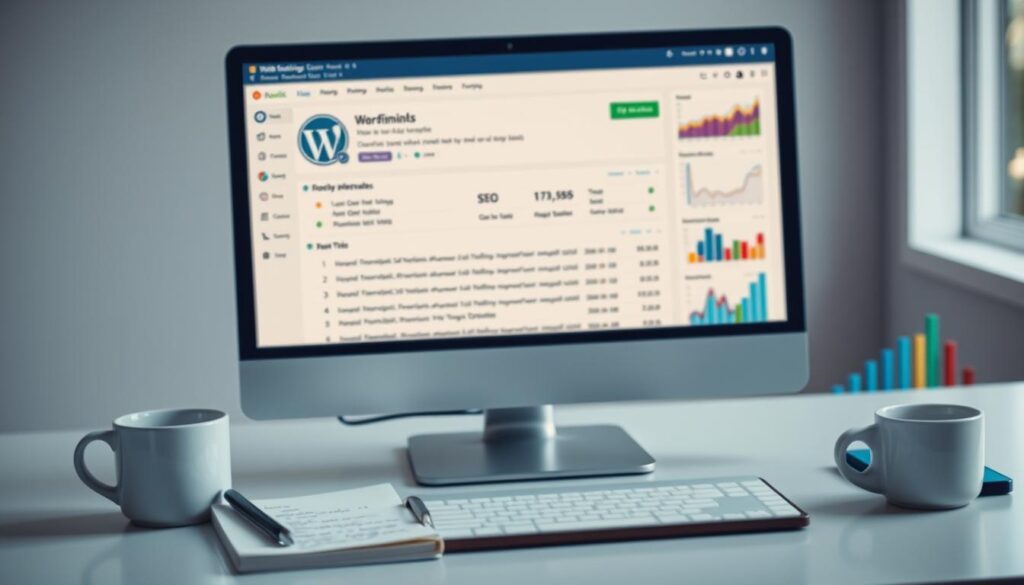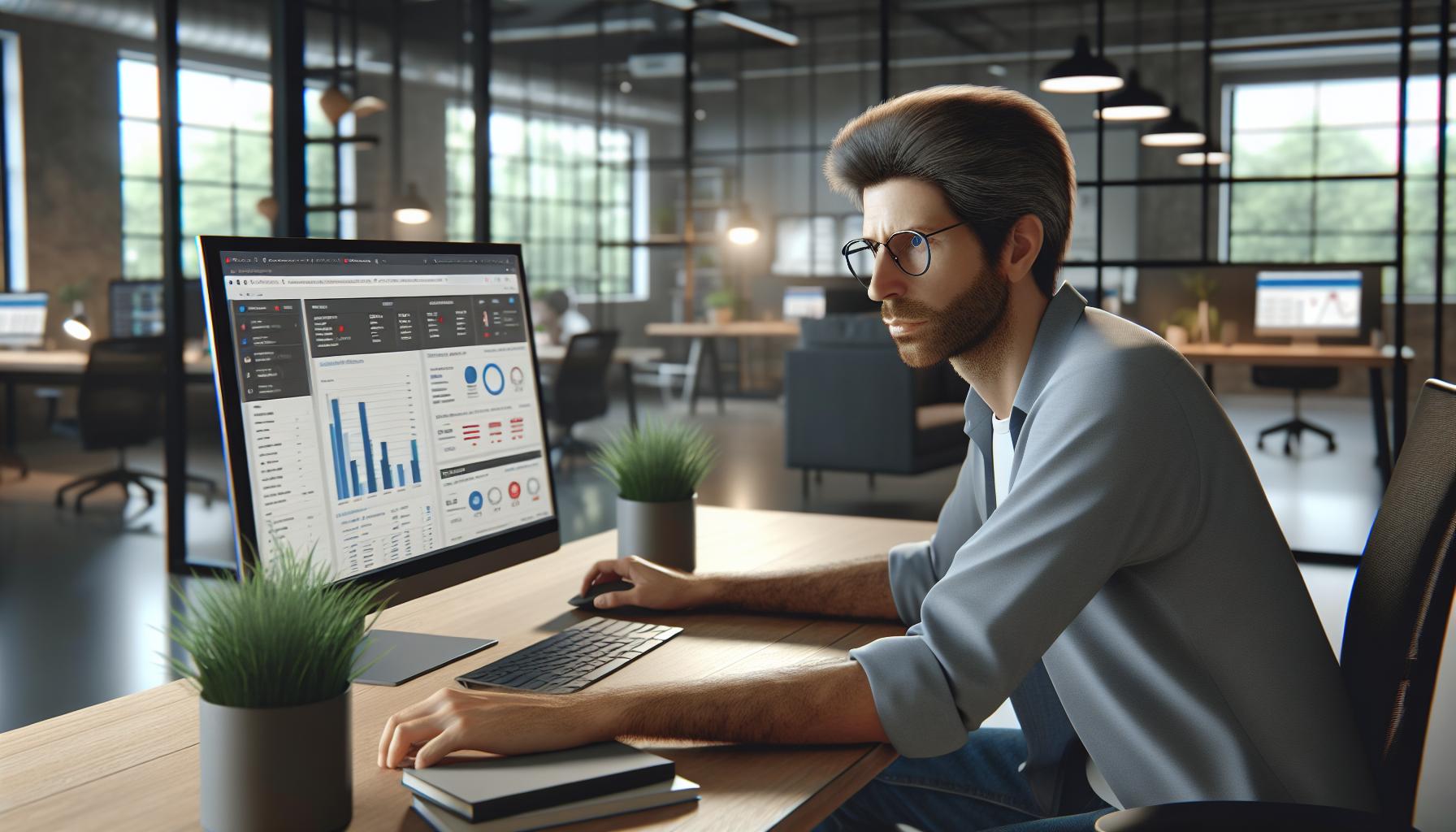WordPress On Page SEO: How To Boost Your Rankings In 2025

Did you know Google might need four to six weeks to notice your new site? This fact shows how crucial on-page SEO is for your WordPress site. Good SEO speeds up indexing and boosts your site’s visibility on search engines like Google. By using the right strategies, you can climb higher in rankings and get more visitors.
This article will cover useful tips and practices for on-page SEO. You’ll find out how to improve your content, pick the best plugins, and use image optimization. All these steps will help make your WordPress site more noticeable.
Key Takeaways
- Understanding on-page SEO is key to better site rankings.
- Updating content regularly makes your site more visible to search engines.
- Using keywords the right way improves your SEO.
- Optimizing images with the right alt text helps with rankings.
- Choosing a good SEO plugin can really make your site stand out.
- It’s important to regularly check your SEO status for long-term success.
Understanding SEO and Its Importance
SEO stands for search engine optimization. It’s a key method to drive more organic traffic to your website. Knowing about SEO can help your content rank better in search results. By using SEO, your site becomes more visible on search engines, attracting more visitors.
Defining SEO and Its Benefits
SEO includes various techniques to boost your website’s ranking in search results. Effective SEO offers many benefits, including:
- Increased visibility in search results
- Higher click-through rates for your site
- Enhanced credibility and authority in your niche
- Better user experience and website performance
- Higher conversion rates compared to other traffic sources
Often, the top three Google results get the most clicks. This highlights the value of strong SEO for boosting web traffic.
Why Invest in SEO for Your WordPress Site
SEO investment is crucial, especially for WordPress sites. WordPress has SEO-friendly features and plugins, like Yoast SEO. These tools help improve your site’s search engine ranking. It’s also important to have SSL and HTTPS for site security, as recommended by Google. Keeping a consistent site format and structure helps too.
Good SEO is a long-term commitment. It’s like running a marathon, not a quick race. Your hard work will bring more visitors, increase conversions, and boost your site’s authority. This establishes your business as a trusted name in your field.
WordPress On Page SEO: Key Components

Understanding on-page SEO is key for boosting your website’s presence. It includes elements like titles, headings, and content quality. By focusing on these, you can lay a strong groundwork for better search engine rankings.
What is On Page SEO?
On-page SEO is all about improving your site’s position in search results through practices implemented on your site. It involves optimizing content, HTML, linking, and media files. This makes your site easier for search engines and users to understand. Effective on-page SEO can lead to more traffic and better user engagement.
The Role of Content Quality in SEO
Great content quality is essential for higher search engine rankings. Creating valuable, high-quality content ensures users find what they need on your site. Following Google’s E-A-T guidelines is vital for your site’s credibility. Also, using links wisely can enhance user engagement and content trustworthiness.
Keeping meta titles and descriptions concise is also important for SEO. Combining superb content with solid on-page SEO strategies paves the way for online success.
Checking Your WordPress Visibility Settings

Making sure your WordPress visibility settings are right is key to getting your site out there. If your site is public, search engines like Google can find and show your content. We’ll show you how to find these settings and make your site ready for search engines.
How to Access Your Settings
To start, head over to your WordPress dashboard. Click on Settings, then Reading. You’ll see an option that says “Discourage search engines from indexing this site.” Make sure this is not selected. This way, search engines can discover your content, helping people find your site.
Making Your Site Public for Indexing
Once you’ve made sure your site can be found, it gets easier for search engines to add you to searches. But remember, new sites might take a bit to show up in search results. Keep checking and tweaking your site to stay visible. Adding structured data markup can also boost your visibility, bringing more visitors your way.
Optimizing Permalinks for Better SEO

Understanding permalinks is key for boosting your site’s SEO. Clean URLs make the site easier to use and help search engines sort your content. They offer insight into the page’s content for both users and search engines. Optimizing permalinks can greatly improve how you rank in search results.
The Importance of Clean URLs
Clean URLs make for a better user experience and boost SEO. A well-made permalink shows how pages on your site relate to each other. Google uses clear URLs to index your site more easily. Avoid URLs filled with unnecessary words or characters. They can confuse users and search engines. For the best results, keep permalinks short, under 100 characters is best. This improves click rates and makes your content seem current by skipping dates in URLs.
How to Edit Permalinks in WordPress
To change permalinks in WordPress, go to Settings then Permalinks. Pick a structure that meets your site’s needs. The Post Name option is best as it makes URLs from post titles. This helps SEO and attracts more visitors. If you change them, use 301 redirects to keep the SEO benefits and avoid broken links. Also, try Permalink Manager Pro for better control. It lets you make custom structures to fit your content better.
Utilizing Tags and Categories

Having a good content organization increases your site’s visibility online. By using tags and categories, your site becomes easier to use and performs better in search results. It’s important to know how each one works on your WordPress site to use them well.
Benefits of Tags for SEO
Tags help detail your posts more than categories do. They make it easier for people to find their way around your website. Using up to 10 tags per post is best for keeping things simple. Always use lowercase for tags to keep the look consistent.
Even though search engines usually don’t index tags, using them correctly is still important. Pick tags that are directly related to your post’s topic. Avoid using too many, as it can make your site harder to navigate.
Organizing Content with Categories
Categories group your content into wider themes, with each post belonging to at least one. Keeping your categories between 5 and 10 helps maintain focus and clarity. A well-organized category list improves how search engines understand your website.
Categories are seen by search engines, making them key for organizing your content. It’s best not to include them in your site’s permalinks to keep URLs simple. This careful approach can make a big difference in your site’s SEO performance.
Choosing and Configuring an SEO Plugin
Picking the right SEO plugin is key to boosting your WordPress site’s SEO. With so many options, deciding can feel tough. Popular picks like Yoast SEO, All in One SEO Pack, and Rank Math help increase website visibility and SEO. They come packed with features designed to enhance your site.
Top SEO Plugins for WordPress
SEO plugins are a big help to website owners. They make SEO tasks easier. Here are some top plugins:
- Yoast SEO: It’s easy to use and has lots of on-page SEO tools.
- All in One SEO Pack: Boasts over 3 million installs, offering on-page analysis and local SEO help.
- Rank Math: Offers advanced tools like rich snippets and aids in local SEO.
Features to Look for in an SEO Plugin
Look for these features when choosing an SEO plugin:
- Keyword Optimization Tools: They help you target content to your audience.
- XML Sitemap Generation: Helps search engines index your content, even though it’s not a direct ranking factor.
- Meta Tags Customization: This is key for making your content look better to search engines.
- Social Media Integration: Helps in sharing your content and enhances your online presence.
- Customization Options: Allows you to adjust the plugin to fit your SEO strategy better.
Using an SEO plugin optimizes your site more efficiently. It gives you analytics on keyword rankings, traffic, and click-through rates. This information helps you make smart decisions for your website’s growth. These plugins work well with WordPress, avoiding conflicts with other tools.
Enhancing User Experience and Site Speed
User experience is key in digital marketing. It shapes how users interact with websites. Site speed is crucial to this. Slow speeds make visitors frustrated. This results in higher bounce rates and less engagement. For good SEO, it’s essential to focus on load speed.
Importance of Load Speed for SEO
Websites that load fast rank better on search results. Google sees load speed as important, thanks to Core Web Vitals. These include things like Largest Contentful Paint and Cumulative Layout Shift. Quick load times keep visitors on the site. It also helps web crawlers index your site better. Using services like managed WordPress hosting can really speed things up. This gives you better resources and optimized performance.
Tools to Measure and Improve Site Speed
To measure site speed, you need the right tools. Google PageSpeed Insights and GTmetrix offer deep insights into performance. Here is a look at how hosting affects speed:
| Hosting Type | Load Speed Impact |
|---|---|
| Shared Hosting | Slower load times due to limited resources |
| Dedicated Hosting | Faster load speeds as resources are exclusively yours |
| Managed WordPress Hosting | Significant improvements specifically tailored for WordPress |
Optimizing images also helps with load speed. Use formats like WebP and compress images. Lazy loading helps by reducing initial load time. Using efficient plugins and themes like Astra and GeneratePress improves performance. This all contributes to faster load times and a better user experience.
Implementing Image Optimization Techniques
Improving your website’s performance is key. Selecting the right file format and compressing images are top methods. Also, using descriptive alt text and captions can boost your online presence. These steps make your visuals SEO-friendly and improve the user’s experience.
Why Image Optimization Matters
Optimizing images is crucial for your site’s speed and reaching more users. Google Images sees over 1 billion searches each day. So, making your images stand out is vital. Moreover, about 20.45% of all searches are for images, highlighting the importance of optimization. Smaller images speed up your site, impacting your Google ranking.
Adding Alt Text and Descriptions
Alt text helps both visually-impaired users and search engines understand your content. Choose descriptive file names like “my-new-black-kitten.jpg” over vague ones. Avoid cramming too many keywords into your alt text. Focus on clarity and relevance. Include captions, making your content easier to scan, especially for images that showcase events or products.
| Image Format | Quality | File Size | Best Use |
|---|---|---|---|
| JPEG | Lower quality | Smaller | Photographs |
| PNG | Higher quality | Larger | Graphics with transparency |
| WebP | Lossless compression | Small | General web images |
| SVG | High quality | Very small | Logos and icons |
Create unique images to draw more traffic than stock photos do. Ensure your images adjust for all devices. These practices boost your SEO and make your site user-friendly.
Conclusion
Mastering WordPress on-page SEO is key to making your site more visible and improving rankings. WordPress runs over 40% of the web, so knowing how to optimize your site on this platform is very important. It can really help your online presence grow. By improving things like permalinks, using tags and categories smartly, and making your site faster, you draw more visitors.
Keeping your content fresh and your WordPress site up-to-date makes your website engaging and relevant. SEO tools like Yoast SEO or Rank Math can make optimizing your site simpler and more effective. It’s important to find a good mix of great content and smart technical tweaks to make search engines notice your site.
Stick to these approaches consistently, and you’ll see lasting benefits. Your content will not just reach more people, but it will also connect with the right audience. Start using WordPress on-page SEO effectively. You’ll see your rankings climb as a result of your hard work and dedication to making your site the best it can be.





